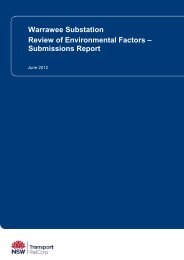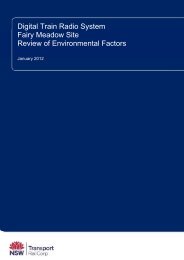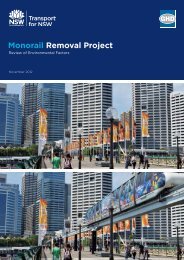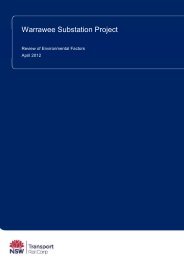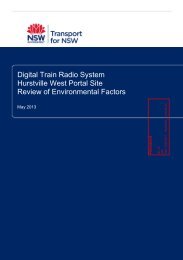Opus International Consultants (NSW) Pty Ltd - Transport for NSW ...
Opus International Consultants (NSW) Pty Ltd - Transport for NSW ...
Opus International Consultants (NSW) Pty Ltd - Transport for NSW ...
Create successful ePaper yourself
Turn your PDF publications into a flip-book with our unique Google optimized e-Paper software.
Appendix AReport Number610.08297Page 2 of 26 ImpulsivenessAn impulsive noise is characterised by one or more shortsharp peaks in the time domain, such as occurs duringhammering.7 Frequency AnalysisFrequency analysis is the process used to examine the tones(or frequency components) which make up the overall noise orvibration signal. This analysis was traditionally carried outusing analogue electronic filters, but is now normally carriedout using Fast Fourier Trans<strong>for</strong>m (FFT) analysers.The units <strong>for</strong> frequency are Hertz (Hz), which represent thenumber of cycles per second.Frequency analysis can be in: Octave bands (where the centre frequency and width ofeach band is double the previous band) 1/3 octave bands (3 bands in each octave band) Narrow band (where the spectrum is divided into 400 ormore bands of equal width)The following figure shows a 1/3 octave band frequencyanalysis where the noise is dominated by the 200 Hz band.Note that the indicated level of each individual band is lessthan the overall level, which is the logarithmic sum of thebands.Sound Pressure Level (dBA)9080706050409 Human Perception of VibrationPeople are able to “feel” vibration at levels lower than thoserequired to cause even superficial damage to the mostsusceptible classes of building (even though they may not bedisturbed by the motion). An individual's perception of motionor response to vibration depends very strongly on previousexperience and expectations, and on other connotationsassociated with the perceived source of the vibration. Forexample, the vibration that a person responds to as “normal”in a car, bus or train is considerably higher than what isperceived as “normal” in a shop, office or dwelling.10 Over-PressureThe term “over-pressure” is used to describe the air pressurepulse emitted during blasting or similar events. The peak levelof an event is normally measured using a microphone in thesame manner as linear noise (ie unweighted), at frequenciesboth in and below the audible range.11 Ground-borne Noise, Structure-borneNoise and Regenerated NoiseNoise that propagates through a structure as vibration and isradiated by vibrating wall and floor surfaces is termed“structure-borne noise”, “ground-borne noise” or “regeneratednoise”. This noise originates as vibration and propagatesbetween the source and receiver through the ground and/orbuilding structural elements, rather than through the air.Typical sources of ground-borne or structure-borne noiseinclude tunnelling works, underground railways, excavationplant (eg rockbreakers), and building services plant (eg fans,compressors and generators).The following figure presents the various paths by whichvibration and ground-borne noise may be transmitted betweena source and receiver <strong>for</strong> construction activities occurringwithin a tunnel.30125160200250315400500630800100012501600200025003150Overall1/3 Octave Band Centre Frequency (Hz)8 VibrationVibration may be defined as cyclic or transient motion. Thismotion can be measured in terms of its displacement, velocityor acceleration. Most assessments of human response tovibration or the risk of damage to buildings use measurementsof vibration velocity. These may be expressed in terms of“peak” velocity or “rms” velocity.The <strong>for</strong>mer is the maximum instantaneous velocity, withoutany averaging, and is sometimes referred to as “peak particlevelocity”, or PPV. The latter incorporates “root mean squared”averaging over some defined time period.Vibration measurements may be carried out in a single axis oralternatively as triaxial measurements. Where triaxialmeasurements are used, the axes are commonly designatedvertical, longitudinal (aligned toward the source) andtransverse.The common units <strong>for</strong> velocity are millimetres per second(mm/s). As with noise, decibel units can also be used, inwhich case the reference level should always be stated. Avibration level V, expressed in mm/s can be converted todecibels by the <strong>for</strong>mula 20 log (V/Vo), where Vo is the referencelevel (10 -9 m/s). Care is required in this regard, as otherreference levels may be used by some organizations.The term “regenerated noise” is also used in other instanceswhere energy is converted to noise away from the primarysource. One example would be a fan blowing air through adischarge grill. The fan is the energy source and primary noisesource. Additional noise may be created by the aerodynamiceffect of the discharge grill in the airstream. This secondarynoise is referred to as regenerated noise.Heggies <strong>Pty</strong> <strong>Ltd</strong>A member of SLR Group







